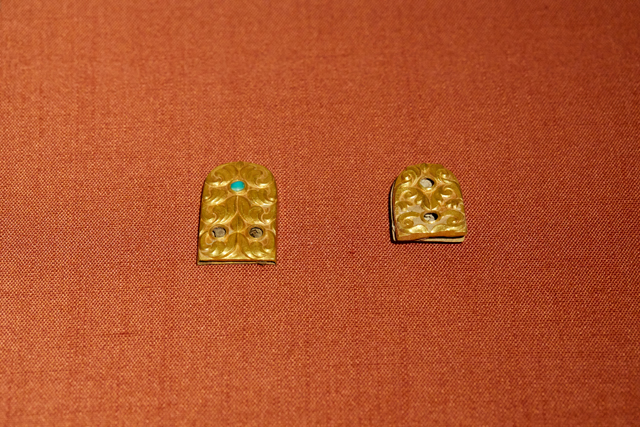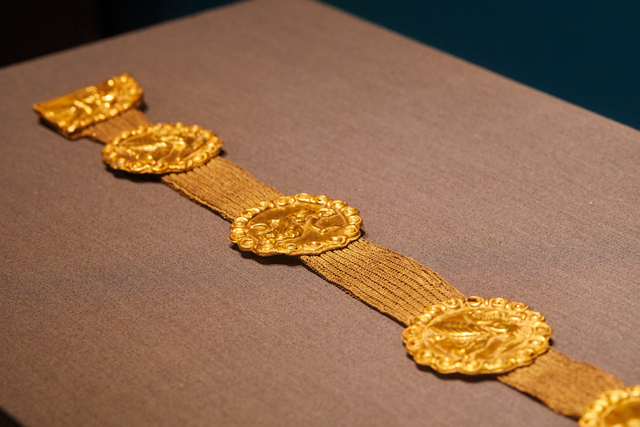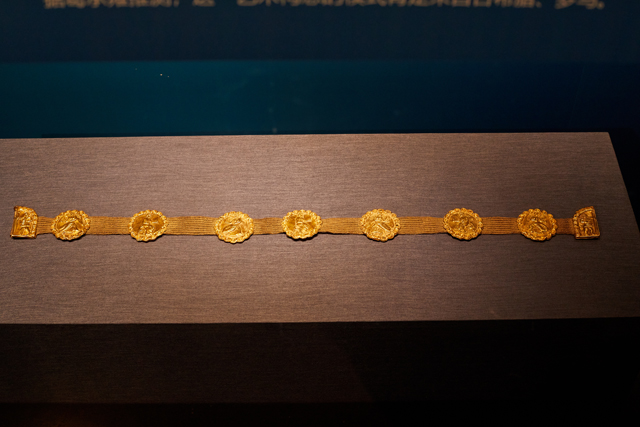Exhibition place:First Floor, Fashion Gallery, China Silk Museum
Exhibition time:2022.6 - 2022.8
Forward
Qinghai is located in the northwest of China, the northeast of the Qinghai-Tibet Plateau. It is bounded to the north and east by Gansu province, to the southeast by Sichuan province, to the south and west by the Tibet Autonomous Region, and to the west and northwest by the Uygur Autonomous Region of Xinjiang.
The Qinghai Silk Road was developed very early, but its prosperity was in the Tuyuhun period. At the beginning of the 4th century A.D., Murong Tuyuhun of the Xianbei tribe moved west to Qinghai and built the Kingdom in about 313, which was destroyed by Tubo in 663, lasting for about 350 years.
The exhibition briefly describes the history of the Tuyuhun Kingdom and, based on archaeological discoveries related to the Tuyuhun-Tubo in Haixi Mongol and Tibetan Autonomous Prefecture over the past 40 years, shows the livings, culture and art history of the Tuyuhun people from the 6th-8th centuries.
Part 1 History of Tuyuhun
Originally belonging to the Murong Xianbei nomads, Tuyuhun arrived in Qinghai in the early 4th century AD and established the Tuyuhun Kingdom. In its heyday, it occupied the land of 4,000 miles from east to west and 2,000 miles from north to south, and completely controlled the Qinghai region, making outstanding contributions to the development of the Qinghai Path, as well as to trade and cultural exchanges between the East and West. In 663 A.D., Tuyuhun was attacked by Tubo. Noghosi, Khan of Tuyuhun, fled to Liangzhou with Princess Honghua, his wife, and thousands of clan members. Tuyuhun Kingdom was conquered. The Tubo took over control of the Qinghai region and the Qinghai Path.

Tomb Figurines of Two Men with Headdress
Tang Dynasty
Gansu Provincial Institute of Cultural Relics and Archaeology
Part 2 Wearing Apparel, Diet, Horse Riding and Arrow Shooting
Tuyuhun, the nomads, lived on herdings, while they also do hunting, handicrafts, agriculture and trading. Among them, hunting could also served the function of recreation and military training. Under the influence of Xianbei culture, Han culture, Qiang culture, and culture of China’s Western Regions, the Tuyuhun people gradually formed distinctive cultural customs. For example, their diet was mostly based on meat and cheese, and their costumes had the characteristics of Xianbei, as well as those of Tibetan, Western Regions and Han.


Gilt Silver Figurine Ornaments
633—842
Qinghai Tibetan Culture Museum

Headdress with Confronted Deer and Floral Pattern in Pearl Medallion
Tang Dynasty
CNSM

Embroidered Sock with Floral Medallion on Red Ground
Tang Dynasty
Qinghai Provincial Institute of Cultural Relics and Archaeology

Gold Belt Fragments Inlaid with Turquoise
Tang Dynasty
Dulan Museum


Gold Buckle (Left1&2), Gold Belt-End
Tang Dynasty
Haixi Museum

Bodiess Lacquer Tray
Tang Dynasty
Dulan Museum

Gold Plaque with Horse Riding and Arrow Shooting
Tang Dynasty
Dulan Museum

Gold Plaque with a Figure Riding a Horse
Tang Dynasty
Haixi Museum

Gold Saddletree and Saddle Flap
Tang Dynasty
Dulan Museum

Embroidery with Phoenix and Floral Scroll Pattern
Tang Dynasty
CNSM

Gilt Silver Rabbit-shaped Plaque
633—842
Qinghai Tibetan Culture Museum

Gilt Silver Bear-shaped Plaque
633—842
Qinghai Tibetan Culture Museum
Part 3 Treasures of the Silk Roads
Qinghai Path played a crucial role in the period of 6th-8th centuries. Since the Wei and Jin dynasties, wars were so frequently that the Silk Roads through the Hexi Corridor were almost blocked. Thus, trade and exchange between the east and west had to be carried out through Qinghai only, called Tuyuhun Path. It is recorded that Emperor Yang of Sui dynasty had passed through Qinghai on his western tour. There were also monks such as Fa Xian, Huisheng and Song Yun, as well as batches of merchants walking to and from. It is because of the 300 years of interaction, there are a large number of precious cultural sites and relics unearthed along the Qinghai Path.
King with Double-Winged Crowns

Gilt Tin Plate with Figures
Tang Dynasty
Dulan Museum

Jin-silk with Lotus and Double Winged Pattern
535-591
CNSM

Sassanian Silver Coins
224-261
Qinghai Provincial Museum
Winged-Horse

Samite with Winged-Horse on Red Ground
Tang Dynasty
CNSM

Samite with Winged-horse in Pearl Roundels
Tang Dynasty
CNSM
Lion

Gilt Wooden Lion
Tang Dynasty
Qinghai Provincial Institute of Cultural Relics and Archaeology
Greek Elements

Gilt Silver Plate with Greek Figures
Tang Dynasty
Dulan Museum


Gilt Silver Belt with Greek Gods in Pearl Roundels
Tang Dynasty
Qinghai Provincial Museum

Gold Plaque with a Figure and a Fishtail
Tang Dynasty
Dulan Museum
Gems along the Way


Agate Cup
Tang Dynasty
Dulan Museum

Calcite Necklace
Tang Dynasty
Qinghai Provincial Institute of Cultural Relics and Archaeology

Glaze Beads with Dragonfly Eye Pattern
Tang Dynasty
Qinghai Provincial Institute of Cultural Relics and Archaeology

Gold Plaques Inlaid with Gems
633年—842
Qinghai Tibetan Culture Museum

Crystal Beads
Tang Dynasty
Dulan Museum
Eastern Influence

Gilt Silver Plaque with Bird in a Lobed Roundel
Qinghai Tibetan Culture Museum

Gold Plaque with Flower-and-grass Pattern
Tang Dynasty
Haixi Museum
Part 4 Archaeology in Haixi
The archaeological research on Tuyuhun and Tubo in Haixi of Qinghai Province has been conducted for 40 years, which has experienced three stages: the serendipitous discovery in 1982; the early archaeological excavations, which began in 1999; and the joint archaeology and application for world Cultural Heritage, from 1999 to 2018. From 2018 to now, both the crackdown on tomb raiding and archaeological research have been carried out. As archaeological excavations continue to advance, new tombs continue to be discovered, and new research continues to deepen. A large number of outstanding achievements have been made in the Qinghai Path of Silk Roads, tomb structures, coffin panel paintings, silks, gold and silver ware, and Tibetan wooden tablets.

Gold Burial Suits Inlaid with Turquoise
Tang Dynasty
Dulan Museum

Drawings on Coffin Planks
390-460
Qinghai Tibetan Culture Museum
Afterword
Qinghai is located at the western border of China, while Zhejiang is on the eastern coast, but they have a long-standing relationship. In early periods, Silk from Zhejiang came to Qinghai along the Silk Roads, and then westwards. Today, Zhejiang is also an important force in assisting the construction of Qinghai. It is remarkable that the Zhejiang Provincial Headquarters for Aid to Qinghai is established in Haixi Prefecture, with the assistance in various fields, such as industry, agriculture, education, medical care and culture.
Academic institutions and scholars from Zhejiang, in the field of cultural relics and archaeology, especially the protection and research of the silk of the Silk Roads, have established cooperation with Qinghai long ago. It is the 40th anniversary of Reshui archaeology in the year of 2022. Coincidentally, Qinghai is invited as the guest province by the Silk Road Week, organized by State Administration of Cultural Heritage and Zhejiang Provincial People's Government. Therefore, the Zhejiang Provincial Headquarters for Aid made a major decision on cooperative exhibition “Dulan on the Silk Roads: 40 Years of Reshui Archaeology”, and related academic activities.
This exhibition highlights the significant academic value of Reshui archaeology and the important position of Dulan on Qinghai Path of the Silk Roads, by retracing the history of Reshui archaeology in the past 40 years, displaying excavated artifacts and sorting out research results. The exhibition has received great attention and close attention from all parties concerned, as well as the support of relevant archaeologists, historians, conservationists and experts in various fields who have been engaged in excavation work here, for which we would like to express our sincere gratitude.
 Pay attention to us
×
Pay attention to us
×